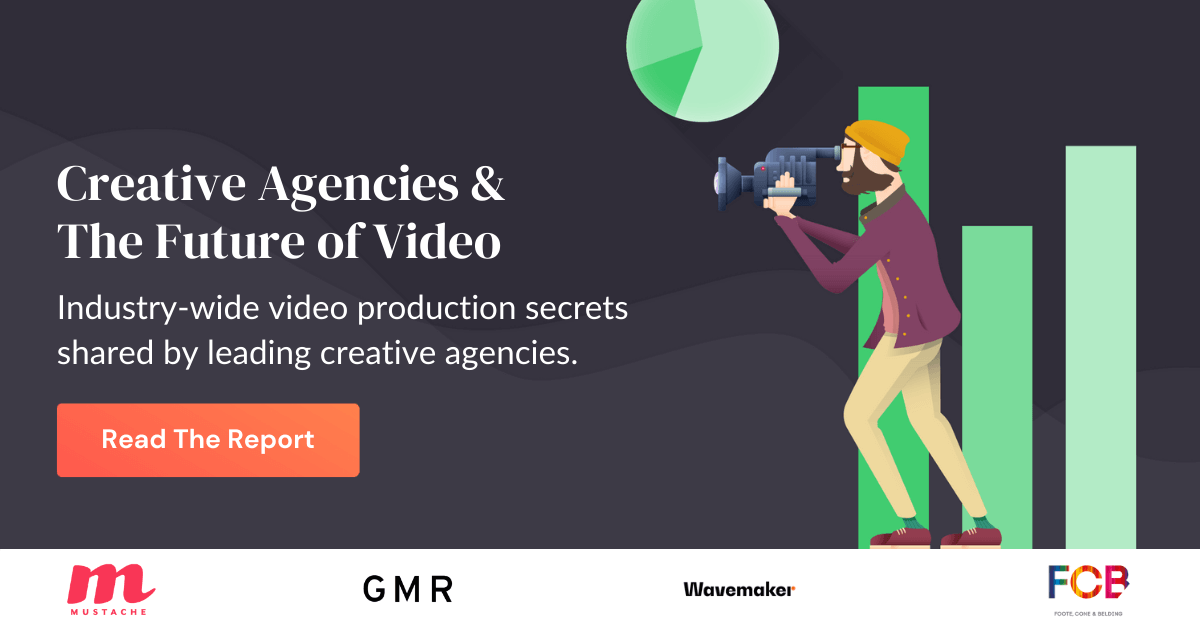
The pandemic has changed how every industry works, and digital and creative agencies are no exception. It’s time to rethink workflows and create a new set of best practices that will allow creative to not only survive in the new economy but thrive.
As a service provider of media asset management (MAM) software to a number of large creative agencies, video production is not only the area in which we have the most expertise — it’s where we can add the most value. Social distancing has both increased the value of video (by accelerating the digital-first economy) and made video production harder. We believe that successful digital and creative agencies will be defined by their approach to this challenge and opportunity.
We just completed a series of interviews with leading representatives of major creative agencies in order to produce a report on the future of the industry. You can access our full finding here — “The Future of Video for Creative Agencies”.
This article will address some of the key takeaways, and explain where MAM can help resolve challenges and create a long-term competitive advantage.
1. Providing remote access to resources
Video is a core part of most creative agencies and it’s not going anywhere anytime soon — 73% of the creative agencies we surveyed currently offer it as a service and 62% said they expected an increase in demand for it in the future.
But the pandemic has made the ability to work on video projects remotely extremely difficult. For instance, it creates a number of challenging technical issues that businesses haven’t had to deal with before:
- Slower internet speeds when working from home
- Hardware/software issues that wouldn't have otherwise been a problem
- Trouble accessing video repositories and archives
- File duplication and redundancies from downloading and uploading
It's also important to mention that when working remotely, accessing your office network securely can be a massive challenge as well.
78% of those we surveyed were using VPNs to address these access issues. But many also admitted that they were feeling the limitations when working with large video files:
“Our VPN is extremely slow. To retrieve one document, it can take hours. Building a better solution is part of our long-term strategy” — Georgina Hajjar, WaveMaker Global
How MAM solves remote access challenges
Advanced MAM tools can help creative agencies address archive access issues quickly for two reasons:
- It centralizes access through the cloud. Since your archive is remote, your team can easily access it from wherever they are with a simple login.
- It uses permission-based frameworks for security. Access is one thing, but unless you have control over who can access what, it’s no better than a VPN.
These benefits have been instrumental in helping agencies stay nimble in agile in the short-term post-pandemic because they make it easy for their teams to work like they're in the office but from home — faster speeds, secure access, etc. because it’s all online.
However, they also improve production workflows for the long-term as well. For example, over half of all professionals said working remotely was one of their most desired benefits in a recent survey. As an agency, if you offer the ability to do so, it's likely that you'll broaden your talent pool.
This also allows you to work with anyone all over the world, and helps to create secure access for freelancers and contractors who may need to access your archive but aren’t full-time employees.
2. Improving remote collaboration
Simply put, creativity is a collaborative force. So without the ability for your team to collaborate effectively on creative projects, the output potential for them is limited.
Unfortunately, the new normal again makes this difficult for agencies who are used to working in an office, where collaborating is easier. In fact, 62% of the creative agencies we surveyed said collaborating remotely was their number one challenge post-pandemic.
So while editors and creatives certainly need access to the resources that allow them to create, access alone won’t solve all of your problems. You need to find ways to help your team work like they were in the office while at home.
There are a lot of collaboration tools that can help you do this, including:
- Project management tools like Basecamp
- Messaging tools like Slack
- Video conferencing tools like Zoom
- Creative tools like Adobe Creative Cloud
However, while these are all important parts of creating a more collaborative workflow, the unique challenge with video production is getting them to integrate well.
How MAM improves remote collaboration
Remote video collaboration is a challenge due to the size of the files you’re typically working with. So although the tools above are helpful (and still essential), working with video files through them can still be cumbersome.
That’s where MAM takes remote collaboration to another level. Advanced MAM tools offer a number of benefits that can help your team create, including:
- Proxies. Proxies are low-res duplicates of your original files that you can edit without changing the master file. Advanced MAMs apply edits to these and only make them permanent when you export the edited file.
- Editing software integrations. Advanced MAMs directly integrate with editors like Adobe Premiere, allowing you to import and work with your archives or proxies without ever downloading a file.
- Traceable edits. One of the reasons Google Docs has become so popular is the ability to see revision history and track edits. Advanced MAMs make it possible to do this with video files as well so you have full visibility over your videos.
- Multi-user access. Multiple people can use or collaborate on the same video file at the same time. And they can also see who has done what.
The best part is that these benefits make collaboration better even if and when you return to the office as well. The ability to work on a single “document” with traceable edits is much more efficient than huddling around an editing bay.
3. Utilizing archived material
The pandemic has severely restricted agencies’ ability to create new material since the need for social distancing has made it harder to set up shoots with multiple people present. This has left many creative agencies scrambling to find ways to repurpose archived assets.
However, finding the right archived asset to incorporate into the current project can be as time-consuming as filming new video. One survey found that creative professionals spend 1 in every 10 hours searching for the right media assets. And when you factor in that working remotely often makes access even harder (slow internet speeds and poor material tagging could mean downloading the wrong file), the new normal could even increase that number.
So while remote access is critical for helping your editors get what they need from home, they still need a way to find the specific material they need quickly and easily.
How MAM streamlines archive access and usage for increased ROI
Archive management is a tedious task for most creative agencies. And that’s where advanced MAM tools can help your team make quick work of tagging and organizing material for your team to use it later. The right tools can even automate this process, and some even have more advanced AI capabilities!
For example, speech and object recognition tools can turn both audio and video into metadata automatically. This means that your team can simply “Ctrl + F” to search your archives without any input from a human being, saving your editors time no matter where they are — at home, in the office, in another country, etc.
Furthermore, it means greater ROI from archived material, since it’s now easier for your teams to reuse it.
Use the right tools to streamline operations post-COVID
Many businesses are preparing for working remotely to be the new normal. Some have even instituted a more permanent work from home policy as a result.
Simply put, the quicker agencies also adopt these new ways of working (and the tools that make it possible), the more streamlined their operations will become. So if there’s anything you should take away from this article, it’s doing so is key to your success now and for the future.
Most importantly, it’s not enough to provide access — you have to foster collaboration. And to do so while also dealing with the large file sizes that almost always come with video, integrations are key. Focus on building a workflow that makes streamlined access and collaboration possible from anywhere!
To learn more about how agencies can streamline video production workflows remotely, check out our eBook — A Creative Agency’s Guide to Video Content Management. Alternatively, if you want to find a tool that does all of the above, our own product — which can be deployed in 36 hours and then scaled to your needs in the future — CuratorNow, may be perfect for your remote creative agency.


Speak Your Mind